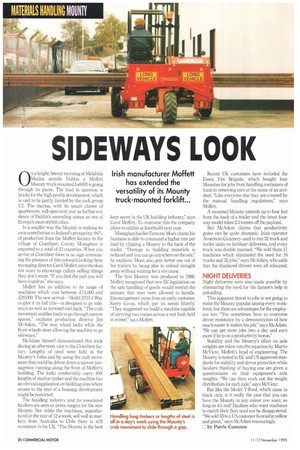SIDEWAYS LOOK
Page 30

If you've noticed an error in this article please click here to report it so we can fix it.
0 n a bright, breezy morning at Malahide Marina outside Dublin a Moffett Mounty truck-mounted forklift is going through its paces. The load in question is bricks for the high-profile development, which is said to be partly funded by the rock group U2. The marina, with its smart cluster of apartments, will open next year as further evidence of Dublin's ascending status as one of Europe's most stylish cities.
In a smaller way the Mounty is making its own contribution to Ireland's prosperity: 94% of production from the Moffett factory in the village of Clontibret, County Monaghan is exported to a total of 23 countries. When you arrive at Clontibret there is no sign announcing the presence of this outward-looking firm; managing director Carol Moffett says she does not want to encourage callers selling things they don't want. "If you find the pub you will have found us," she says.
Moffett has an addition to its range of machines which cost between £15,000 and £29,000. The new arrival—Model 2703 4-Way to give it its full title—is designed to go sideways as well as forward and back. "The crab movement enables loads to go through narrow spaces," explains production director Jim McAdam. "The rear wheel locks while the front wheels steer allowing the machine to go sideways."
McAdam himself demonstrated this trick during an afternoon visit to the Clontibret factory. Lengths of steel were held in the Mounty's forks and by using the crab movement they could be driven down a narrow passageway running along the front of Moffett's building. The forks comfortably carry 40ft lengths of steel or timber and the machine has an obvious application on building sites where access to the rear of a housing development might be restricted.
The building industry and its associated hauliers are seen as prime targets for the new Mounty But while the machines, manufactured at the rate of 12 a week, sell well in markets from Australia to Chile there is still resistence in the UK. "The Mounty is the best kept secret in the UK building industry," says Carol Moffett. To overcome this the company plans to exhibit at lnterbuild next year.
Monaghan haulier Eamonn Moen claims his business is able to command a higher rate per load by clipping a Mounty to the back of the trailer. "Damage to building materials is reduced and you can go anywhere on the site," he explains. Moen also gets better use out of his trailers by being able to unload straight away without waiting for a site crane.
The first Mounry was produced in 1986. Moffett recognised that new EC legislation on the safe handling of goods would restrict the amount that men were allowed to handle. Encouragement came from an early customer, Kerry Co-op, which put its needs bluntly. "They suggested we build a machine capable of carrying two tonnes across a wet Irish field in winter," says Moffett. Recent UK customers have included the Essex Fire Brigade, which bought four Mounties for jobs from handling containers of foam to removing cars at the scene of an accident. "Like everyone else they are covered by the manual handling regulations," says Moffett.
A mounted Mounty extends up to four feet from the back of a trailer and the latest fourway model takes 2.3 tonnes off the payload.
But McAdam claims that productivity gains can be quite dramatic. Irish operator Avonmore Creamery used to run 32 truck and trailer units on fertiliser deliveries, and every truck was double manned. "We sold them 11 machines which eliminated the need for 16 trucks and 32 jobs," says McAdam, who adds that the displaced drivers were all relocated.
NIGHT DELIVERIES
Night deliveries were also made possible by eliminating the need for the farmer's help in unloading.
This apparent threat to jobs is not going to make the Mounty popular among every workforce, but there are advantages for the employees too: "You sometimes have to overcome driver resistance by a demonstration of how much easier it makes his job," says McAdam. "He can get more jobs into a day and earn more if he is on a productivity bonus."
Stability and the Mounry-'s effect on axle weights are taken into the equation by Martin McVicar, Moffett's head of engineering. The Mounty is tested to EC and US approved standards for stability and driver protection while hauliers thinking of buying one are given a questionnaire on their equipment's axle weights. "We can then work out the weight distribution for each axle," says Mc Vicar, But like the Model T-Ford, which came in black only, is it really the case that you can have the Mounty in any colour you want, so long as it's red? Hauliers who want machines to match their fleet need not be disappointed. "We sold 33 to a US customer liveried in yellow and green," says McAdam reassuringly.
El by Patric Curmane




















































































